Featured Motorcyclist – Joe Petrali, Universal Racer
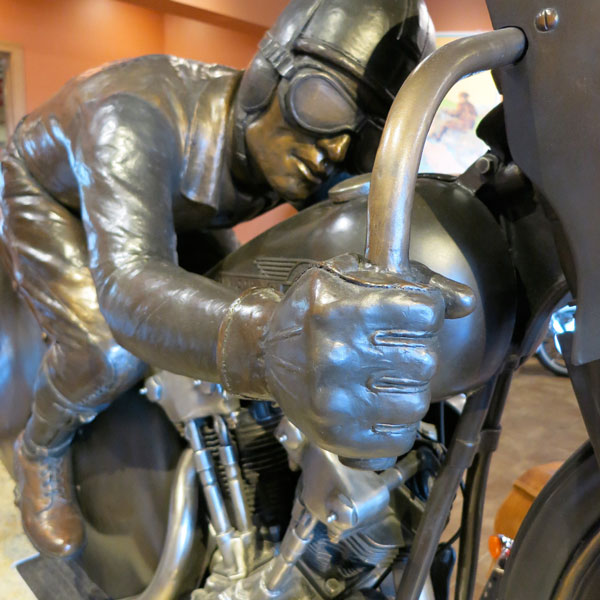
Joe Petrali Streamlined Harley-Davidson bronze sculpture by Jeff Decker
Champion hillclimber and dirt track racer, Joe Petrali had a long career as a very successful “do-it-all” motorcyclist. As with many of us, he got his start in riding through a friend down the street, and in competition because a race track was almost across the street from his home.
Joe Petrali’s first competition event was an “economy run” at the fairgrounds near his home in Sacramento, California. 14 years of age and weighing 80 pounds, Joe tucked in, ran smoothly and recorded 176 miles per gallon and won his class. This was a sanctioned event, and Joe had just won his first national championship.
Ironically, Petrali’s big break came with the death of “Shrimp” Burns, killed in a race in Toledo, Ohio in 1921. After running some local races, Petrali was looking competitive enough that Indian prepped the late Burn’s bike for Joe to ride in Fresno, California. Petrali showed well in race practice except for some tuning problems; Joe had been put out on a bike that was used to conduct a new alcohol fuel test and jetting was a bit off. During this, his first real race, Harley team members apparently boxed him in a bit for part of the race. When he faked an engine problem, and momentarily dropped back, the Harley team riders figured he was no longer a threat. It was then that Joe motored to second place!
Near the end of the great Board Track Racing era, Petrali logged his first really important win. Plans were for him to race an Indian at the famed Altoona, Pennsylvania board track, a 100 mile race on the 1.25 mile board track. With his bike mistakenly shipped to the wrong town, Joe was almost out of a ride. But Harley rider Ralph Hepburn had crashed in practice, was injured and out of the race and offered his bike to Petrali. Joe not only won the race but set a 100.36 mph 100 mile board track record that was never broken. This 1925 win proved to be what set him up as a factory rider with Harley-Davidson. He went on to win three national titles before the 1925 racing season was over.
Joe Petrali also won national titles in 1926 and 1927, the latter on Excelsior race bikes when Harley temporarily pulled out of racing. Seriously injured and out of dirt track racing for about a year, Joe came back and began an assault on hillclimb competitions. 1929 saw him take both 45 and 61 cubic inch championships. His favorite bike, a 61 cubic inch Excelsior he built and dubbed Big Bertha took him over the top of several hillclimb courses; a feat never before accomplished.
As the Depression took its toll on the world and the motorcycle industry, prompting Ignatz Schwinn to stop motorcycle production at Excelsior in 1931, Petralli was out of work, but again recruited by Harley-Davidson. Aboard Harley hillclimbers, Petralli won national championships in 1932, 1933, 1935 and 1936. But by 1937, now married and starting a family, Petrali scaled back his racing partly because the challenge was lessened; he was winning everything including a string of 10 Class A dirt track races in 1935.
Petrali won his 49th and final national championship at the Muskegon, Michigan hillclimb. Scott Parker is the only rider to have bested Petrali’s record. But as he wound down his dirt track and hillclimb career, he dabbled in land speed record competition at Daytona Beach, Florida. There he set a well known record of 136.183 aboard a Harley-Davidson EL overhead valve “Knucklehead” semi-streamlined machine. A striking full-size bronze monument that was created by artist Jeff Decker honors Petrali for this record run and greets visitors as they enter the National Motorcycle Museum.
For his amazing competition riding over nearly a 20 year career, Joe Petrali was inducted into the Motorcycle Hall of Fame in 1998.

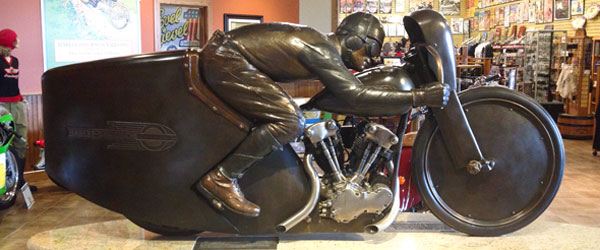
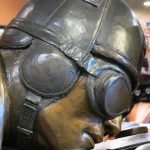
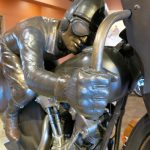
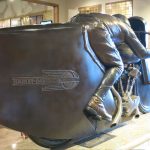
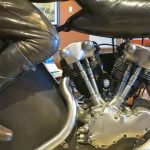

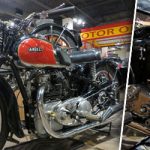
I think joe petrali was great.it,s good you have a statue to him.
The late Neil Cooper, “Mr. Indian”, from Coeur d’ Alene, Idaho, told me that Mr. Petrali got the mission to re-create the Liberty V-12 Aircraft Engine as a Vee Twin Motorcycle Engine, from Ignaz Schwinn. He later migrated over to Indian, and then to Harley. Mr. Cooper had an extensive antique motorcycle collection, and was probably the best M. C. historian in our area. He claimed, that the location of the 36 61’s engine down in between the frame rails was lifted from Big X, and the knuckles are adapted from a radial, not a Vee Twelve, aircraft engine. Whereas the old VD cam is in the bottom of the timing chest, the 61 E’s cam weakens the cases, by being above the crank shaft, in between the barrel spickots. What I didn’t like in the Discovery mini series, is that they showed the 1936 as a finished, not experimental, machine. Indeed it didn’t enclose the top of the valve train, so there was oil splashing all over. Harley salesmen touted their 1936 VLH with its four speed constant mesh tranny, and return oil system, as the real deal. The OHV 3661, was only to be an experiment. But by the end of the year the Knuckleheads were on fire, and the big old VLH’s were heading to the museums. By 1937, the Knuckles were being detuned and had top covers fitted, for the rocker arms, which civilized these machines, for the street. Also the Flat Heads were back, in the ULH’s, with much stronger lower ends, modern combustion chambers, and IIRC, aluminum heads, held down by nine, instead of the VL’s seven head bolts..
I studied the 1937 Enthusiast copy with Joe Petrali’s World Record dash, and compared it to Indian dealers’ dissing of the OHV’s. The street OHV’s are different, despite what the AMA published with their tear down. What isn’t in the record, is how long the con rods were. You can put the longer VL rods into an E model OHV, which will change the rod geometry. Doing this with E model barrels, on a E bottom end, moves the pistons upwards. Doing this with the shorter FL rods, in F.L. jugs, means that you need to use 13 to 1 C.R. piston crowns to equal a stock F.L.’s, compression ratio. Petrali’s engine was supposed to be turning 5000 RPM, so that’s plenty fast for one inch longer rods to give him a real boost. Another Indian Dealer, Alan, “Mac”, McLain, down in Clarkston, WA. said that with its mechanical speedometer pegged at 85mph, a Chief would walk right past a E model 61, with the Harley’s cheap magnetic speedo showing 105mph.
I rebuilt, as good as I could, a 1934 VLD Flathead, converted into an eighty, and there were details in it that never made it to the AMA, or the Enthusiast rag. I was trying to find the strange Auburn Swirl paint job on my 34 Harley, in a photo, when I went through a stack of old Enthusiast magazines. I may have found, just one, in a group photo from about 1937. So my question is: “did the tool room start out using VL rods, and VL quarter inch roller bearing lower ends, with a piston, using a lower crown height, and then transition down to the later 7 inch OHV rods, and a higher piston crown? I’ve seen one of these lashup V.L. crank pins come out in pieces, since they weren’t up to the task. The stepped crank pins were only a stop gap, but they did use the smaller 3/16th’s roller bearing pins. These could, and did, handle the bottom end loads, of the Knuckle Heads.
Mac had the best comeback of them all. He claimed that, “only a Knucklehead, would ride a Knucklehead”. And that old man threw Harley’s dealership recruiters out into the street, in front of his business, on three separate times. Coop worked, and sold Indians, until WWII. Mr. Irwin Walk, was recruited by Bill Harley in 1914 and sold H D’s, here, until he sold it to the Stranahan Brothers in 1925. These three brother’s sold them until fall out from the Marlon Brando movie, crashed the M.C. business, in the Fifties. If there’s one constant, in all these gentleman’s accounts,, its that the American Motorcycle Industry has always been a cut throat business. IMHO, anyway.